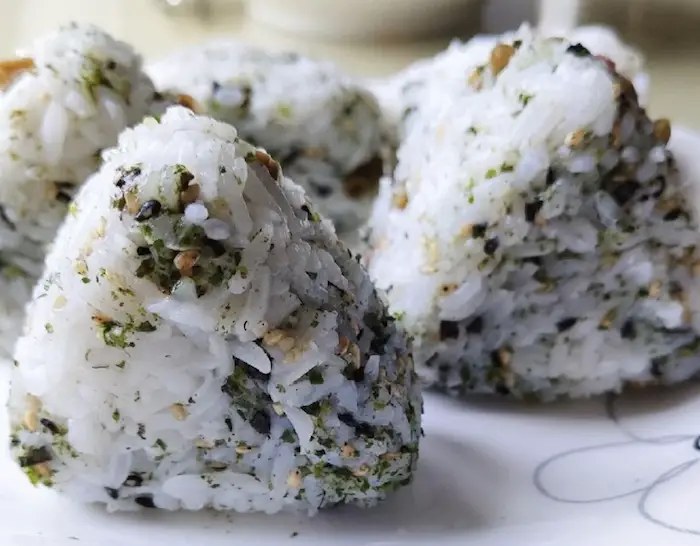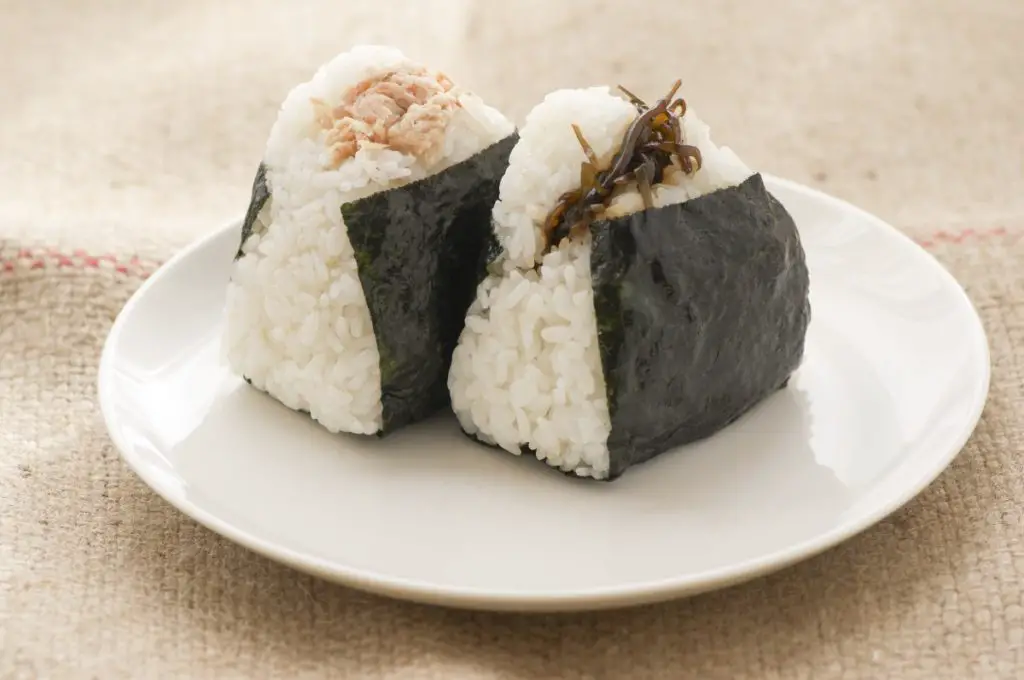We are reader supported. When you purchase through links on our site, we may earn an affiliate commission. Also, as an Amazon affiliate, we earn from qualifying purchases.

If you don’t know what onigiri is, you might have seen it in an anime or movie. Onigiri is simply a rice ball with a surprise filling, often wrapped in nori seaweed and shaped into a triangle. It’s an extremely popular snack in Japan, but foreigners might not know how to approach eating onigiri.
So how do you eat onigiri? Onigiri to the Japanese is a lot like what the sandwich is to Americans, so you simply eat it with your hands, taking small bites at a time. Keep in mind that the nori wrapping is edible and intended to be eaten along with the rice and filling!
In Japanese convenience stores, onigiri is packaged in a special plastic wrapper that keeps the nori separated from the rice to prevent it from getting soggy. Unwrapping this type of onigiri requires a little practice, but the packages usually have numbered tabs and illustrations to help hungry customers get to their snack as easily as possible. Read on to learn about how to unwrap convenience store onigiri and about the many different types of onigiri you may encounter.
Contents
How to Unwrap Convenience Store Onigiri
Step 1: Pull the Plastic Tab
This is the tab labeled with the number “1” if you have purchased your onigiri from a Japanese convenience store. Pulling on this tab will tear the packaging like the plastic tab on a gallon of milk. Continue pulling the tab all the way around the onigiri until the package is divided in half.
Step 2: Pull on the First Corner
Once you’ve torn your package in half, grasp the corner labeled “2” with your dominant hand and the onigiri with the opposite hand. Keep your fingers on the exposed part of the onigiri and apply just enough pressure to hold the nori to the rice without crushing it. Carefully slide corner “2” away from the onigiri while holding the nori in place until the plastic wrapping pulls free.
Step 3: Repeat Step 2 on the Remainder
Grasp the exposed half of the onigiri and repeat step 2 on the remaining corner of the plastic packaging. It’s normal for the nori to unravel slightly as you slide the packaging off the onigiri. Just try your best to keep the integrity of the onigiri as whole as possible.
Step 4: Reassemble If Necessary
Once your onigiri is unwrapped, you may have to refold the corners of the nori against the rice. Smooth down any lumps until your onigiri looks like a triangle again. Then, hold it in both hands and enjoy it!
Variations of Onigiri
Just like sandwiches, there are many different types of onigiri and even more possibilities for fillings. The most ubiquitous form of onigiri is the triangle shape, but you can also find them in square or round shapes. Onigiri can also be made without nori, especially if it’s round.
Nori Maki (Sushi Roll)
Nori maki contains the same ingredients as onigiri, but it’s rolled into cylinders rather than shaped into balls. Many people think nori maki resembles sushi rolls, with seaweed on the outside and rice and filling in the center. Nori maki also differs from onigiri because the rice is seasoned with vinegar before being placed on the nori.
Types of Fillings

Because rice is relatively neutral in flavor, virtually anything can be used to fill onigiri! Some of the more traditional options are:
- Cooked salmon
- Fish eggs
- Ume (pickled plums)
- Tuna and mayo
- Seasoned kelp
- Dried fish
- Tempura
- Fried chicken
As onigiri have become more popular in the West, people have become more creative with onigiri fillings. The following ingredients are common in American households, easy to find, and make a tasty yet unconventional addition to onigiri:
- Peanut butter
- Eggs and ketchup
- Cheese
- Kimchi, with or without cheese
- Spam
- Chicken teryaki
If you wish, you can also have onigiri without any filling at all, which is a lot better than it sounds. Filling-less onigiri is simply salted rice shaped into a ball, with or without nori. For many Japanese, a simple rice ball and a cup of sippable soup is all they need for a satisfying meal!
Don’t Forget Your Manners
Japanese society has flourished on the other side of the world over millennia, so naturally, they have completely different standards of etiquette. In Japan, it’s considered impolite to eat with your hands, but onigiri is one of the rare exceptions to this rule. If you are tucking into your onigiri while you are physically in Japan, remember the following rules.
NEVER Eat and Walk at the Same Time
The availability of onigiri in public markets, along with their portability, makes it tempting to eat them on the go. Unfortunately, littering is extremely taboo in Japanese culture, even if it’s a few wayward crumbs of food. To prevent littering and any discouraging looks from locals, remain seated or standing in one place until you’ve finished eating your onigiri.
Refrain from Adding Condiments
Onigiri is prepared with the pre-seasoned rice. Adding any additional condiments like soy sauce or hot sauce implies that the onigiri wasn’t prepared the “right” way, and you could end up insulting the person who made it for you. If you must, feel free to dress up your onigiri to your heart’s content in the privacy of your own home.
Eat with Both Hands
It’s also impolite in Japanese society to hold your hand under food you may be eating, even if you are trying to catch any falling food. The easiest way to combat this is to hold your onigiri with both hands. Not only does this keep both hands safely planted on your food, but it also helps keep your onigiri in one piece.
Related Questions
How long can onigiri stay in the refrigerator?
Onigiri can be refrigerated safely for about three days, less if the fillings are raw or unstable (e.g., raw fish and eggs). However, refrigerated rice tends to get hard and unappetizing within a few hours, so you may not even want to store it in the refrigerator. If you can’t eat your onigiri right away, consider the freezer instead.
To freeze onigiri, wrap it tightly in plastic wrap, place it in a freezer-safe bag or container, and put it in the freezer. When you’re finally ready to eat, simply reheat your onigiri in the microwave for one to two minutes, depending on the size. Frozen onigiri makes a great take-along lunch for work if your workplace has a microwave.
Can I make onigiri at home?
Yes! All you need is cooked short-grain rice, nori, and the filling of your choice. Simply form a bed of rice on your palm with a small indent in the center, fill the indent with your filling, and pack it together like you’re forming a snowball. Once your filling is enclosed completely in rice, continue shaping the ball until you achieve your desired shape and wrap the final creation in nori
Keep your hands wet to prevent rice from sticking to them. You can place a bowl of clean water nearby for this purpose. Hot rice tends to hold its form better than room temperature rice, so wait until the rice has cooled just enough for you to be able to handle it with bare hands.
Is there an easier way to make onigiri?
Yes, although it’s already pretty simple to make! The hardest part of onigiri-making is probably forming the rice balls. If you’re having trouble with this step, try onigiri molds, which are special plastic molds (see Amazon) specifically intended for making onigiri. Along with triangles, squares, and circles, you can also find molds shaped like stars, bunny rabbits, flowers, dolphins, and more.

